1lumen selects and reviews products personally. We may earn affiliate commissions through our links, which help support our testing.
Skilhunt EK1 review
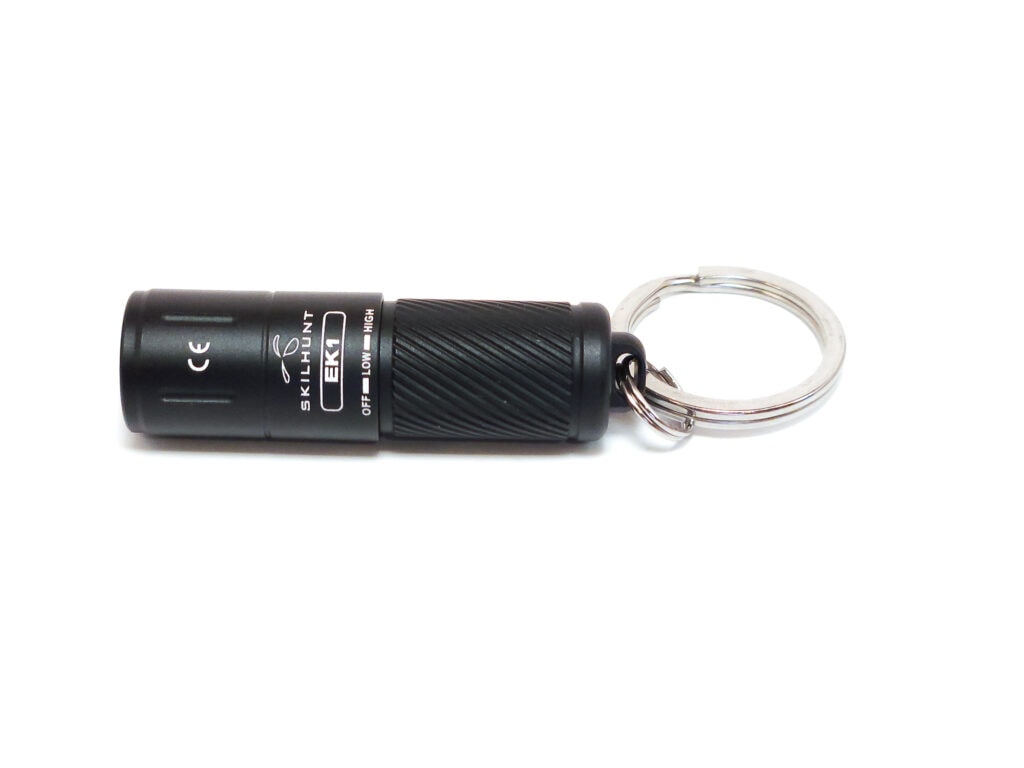
Skilhunt EK1 specifications
| Brand & Model | Skilhunt EK1 |
|---|---|
| Flashlight category | Keychain, EDC |
| LED | Luminus SST-20 6500K (as tested)Nichia 219F 5000K |
| Max. output | 180 lumens |
| Max. beam distance | 66 meters |
| Max. beam intensity | 1100 cd |
| Battery config. | 1*10220 (built in) |
| Onboard charging | USB C |
| Modes | 2 |
| Blinkies | None |
| Waterproof | IPX8 |
| Review publication date | December 2022 |
Introduction:
Skilhunt, known for their selection of EDC and headlights, has added another light to their lineup: The EK1. This is an all-new light, and joins E-series brethren, the E2A and E3A, in the keychain category. Unlike the larger E-series lights (that’s relative, of course, since they use AA and AAA batteries, respectively), the EK1 is the first E-series to use a built-in lithium-ion battery and have onboard USB C charging.
My first thought when seeing the EK1 is that Skilhunt is taking aim at Olight’s i1R2 line of keychain lights since on paper, it’s very similar. Let’s see how it stacks up.
Package quality.
The Skilhunt EK1 comes in a thin paperboard box in Skilhunt’s standard white, gray, and yellow color scheme. This particular one has a plastic window through which you can see the light, which would make a good selling point if it was sold in a physical store, especially since this light comes in four different colors. Beyond that, there’s a sticker placed on the emitter selection for the light inside. The rear of the box lists the features of the EK1 and has a runtime chart for both modes.
Inside the box you will find:
- Skilhunt EK1
- A short USB C charging cable
- A plastic zip-top bag with two spare o-rings and two split ring keyrings; one small and one large
- Instruction manual
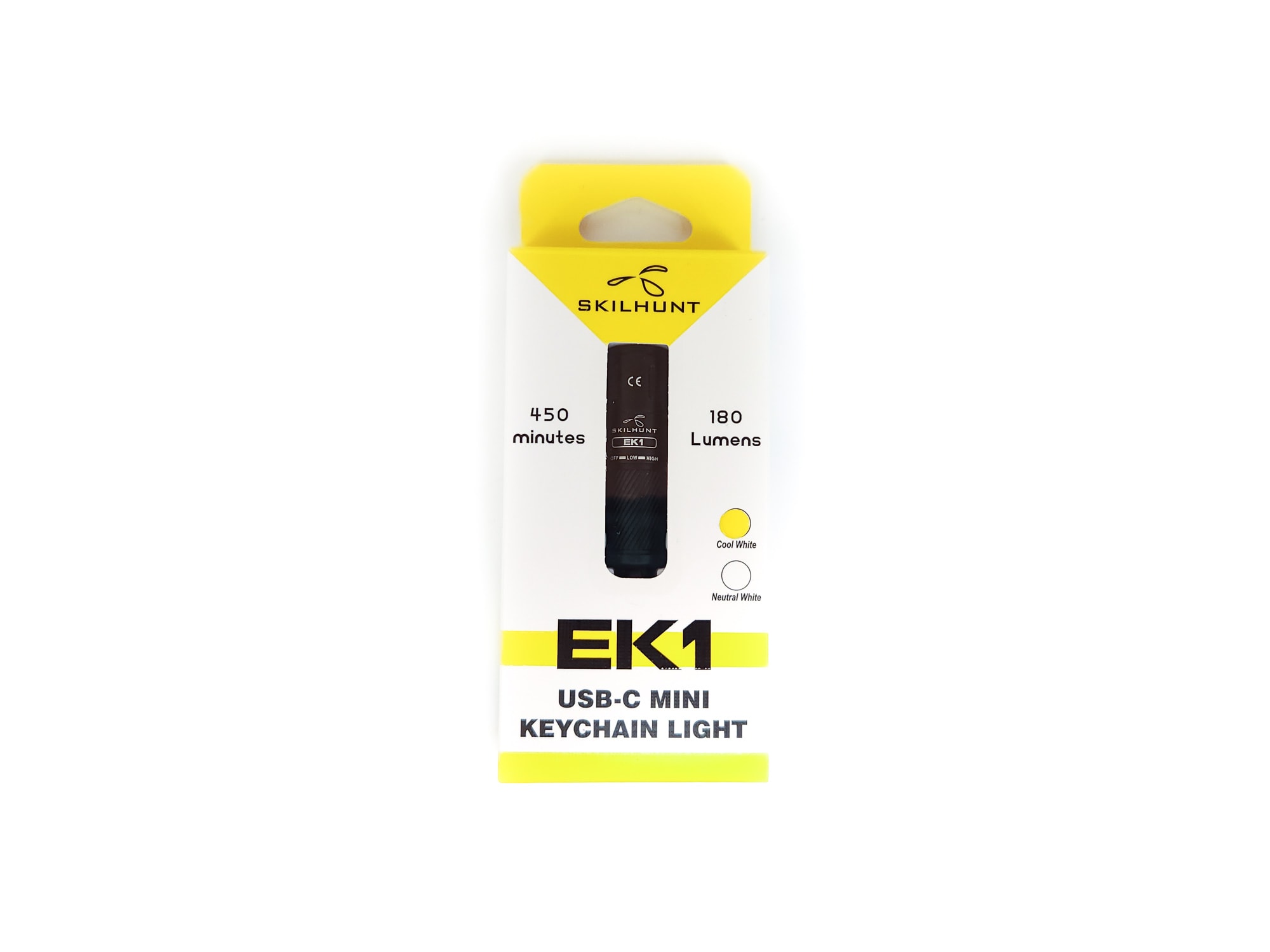
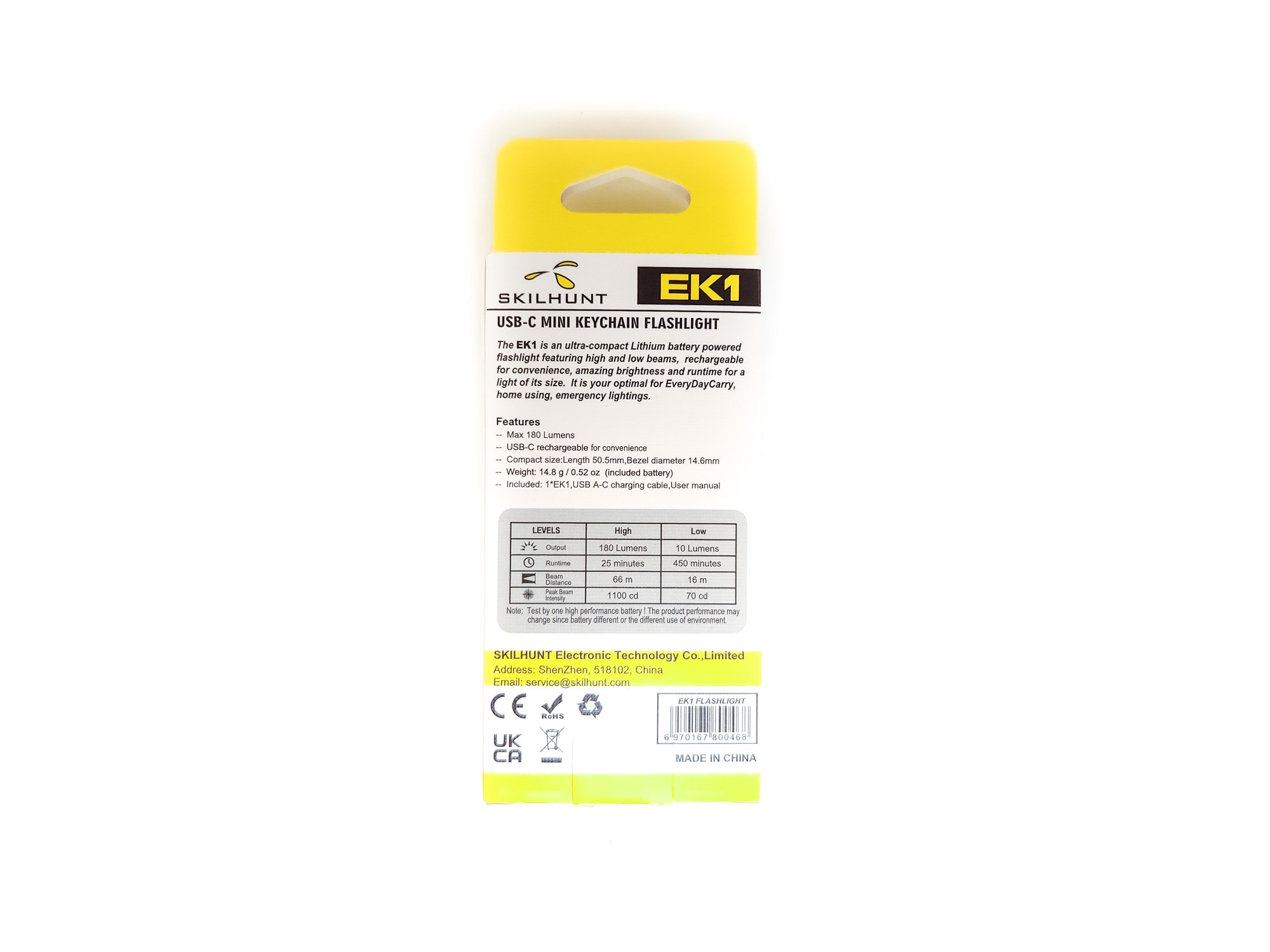
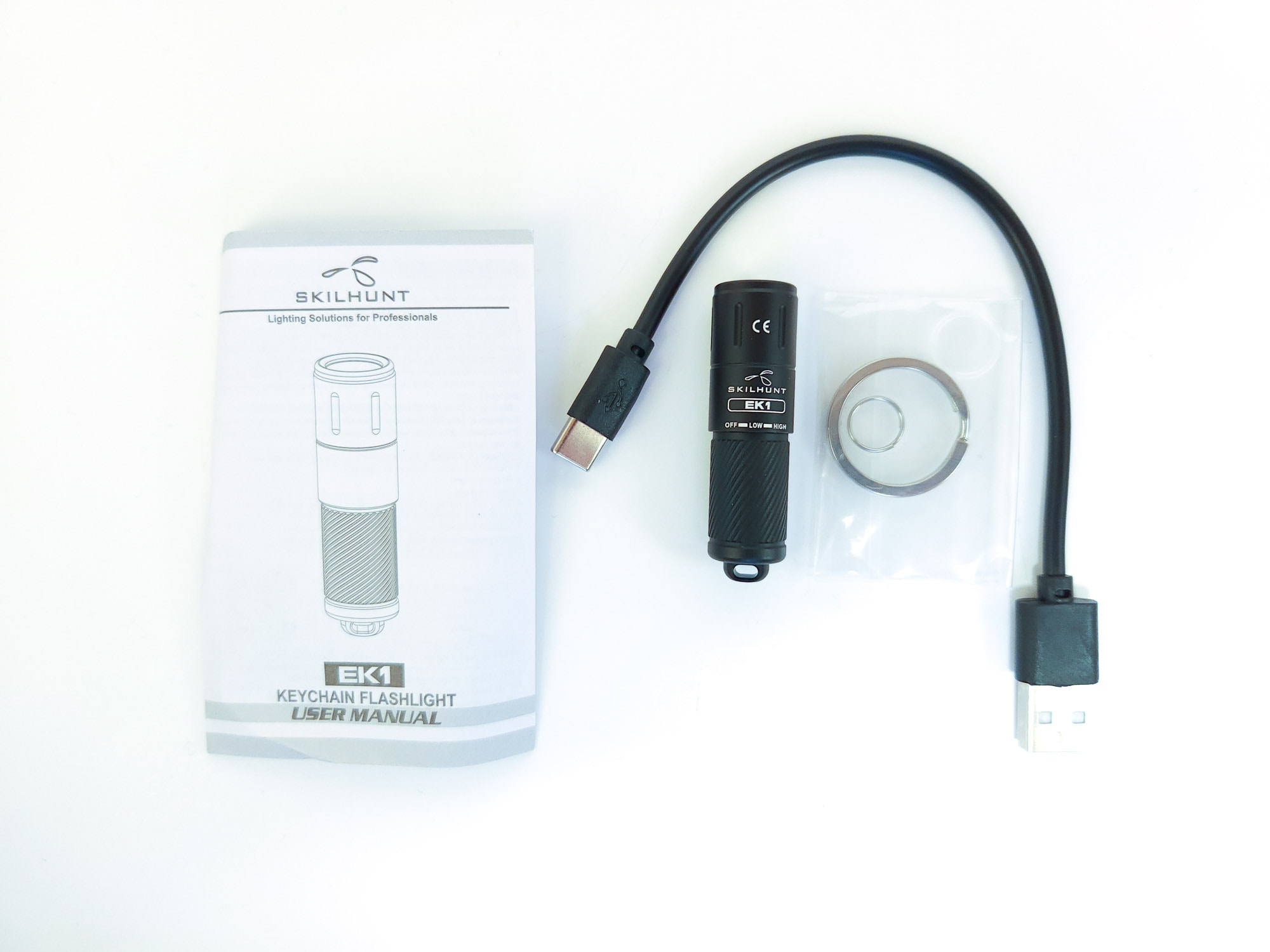
Flashlight in use
First and foremost, the Skilhunt EK1 is a keychain light; there is no clip or any other carry options for this light. But before you go adding your EK1 to your keychain, consider this: I don’t carry a keychain, but I do use my Olight i1R2s as zipper pulls! Aside from making it easier to grab a zipper with gloves on, I’ve got (yet another) light right there! I prefer to use S-biners for easy detachment, but you could use the included keyring or any other number of options to clip the EK1 to your zipper, keychain, or wherever you decide to put it. The sky’s the limit!
The EK1 is a twisty light; something that doesn’t show up much here as it’s only on AA or smaller-sized lights and even then, not all of them are twisties. This makes it easy to operate (even with gloves); you just have to remember which direction to turn it. There’s a diagram of sorts printed on the light under the name which shows “OFF–LOW–HIGH”, a reminder to turn the body of the light in a clockwise manner to activate it. Remember, righty tighty, lefty loosey. There’s only a quarter turn between low and high, so you’ll want to turn it slowly if you’re trying to get to low, otherwise your eyes will be absorbing the difference between 10 and 180 advertised lumens.
Being a keychain light, the EK1 is tiny, coming in at only 50mm (2 inches) long. In fact, the EK1 is small enough to forget about. I almost put it through the wash because I missed it when emptying my pants pockets! For those with big hands, the size can make it challenging to grip, so having the keyring or other attachment option on it actually helps by giving you more space to hang onto it.
Whether you carry the EK1 on your keychain, as a zipper pull, or in some other way, the point of this light is that it’s always on hand. Depending on what other light(s) you carry, it may be easier to grab the EK1 if you need to find something you dropped under your desk or get a better view of the ports on the backside of your TV rather than take out your main light. The EK1 probably won’t replace anyone’s main EDC lights, but it can at least be a backup, or a backup of a backup.
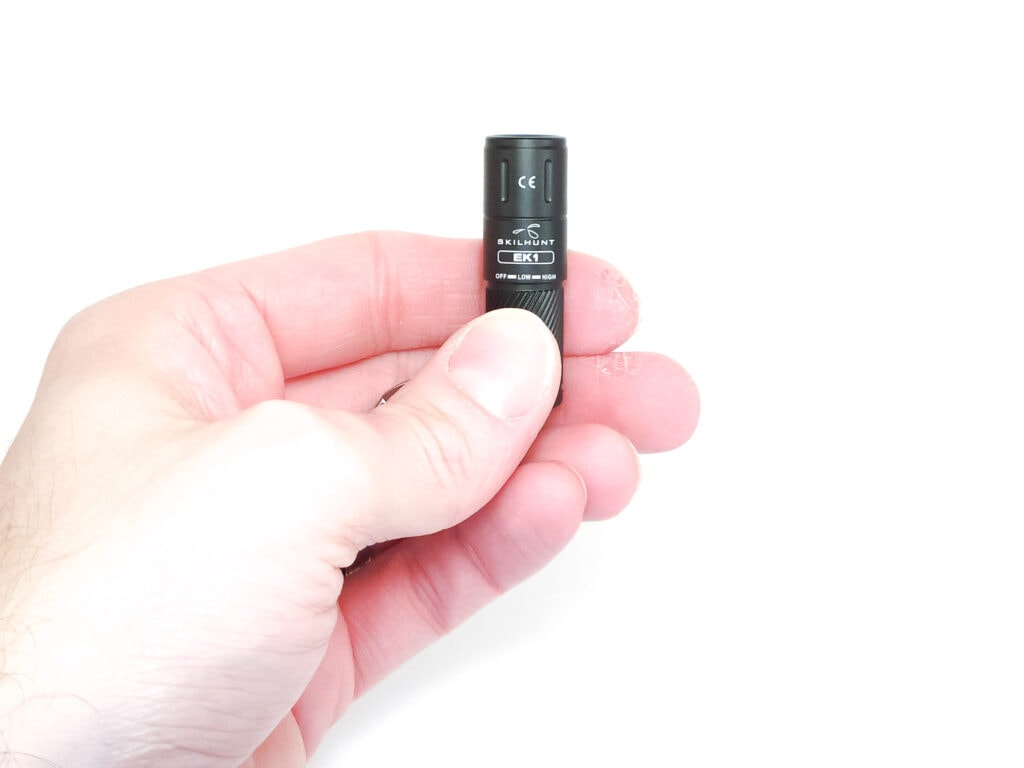
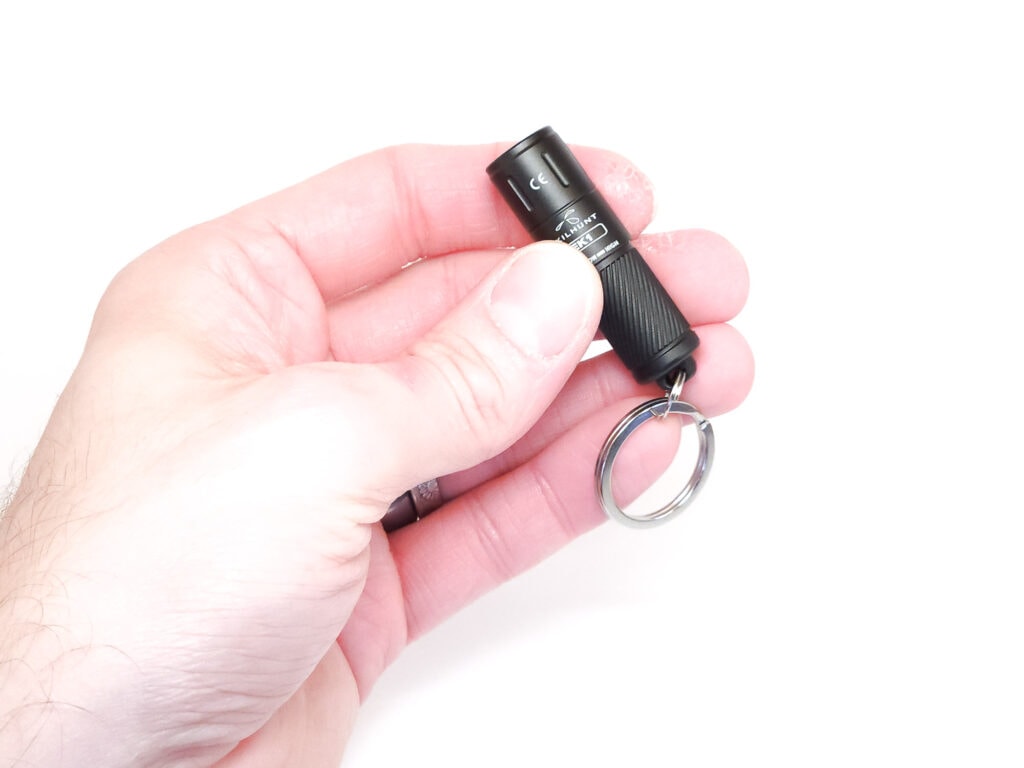
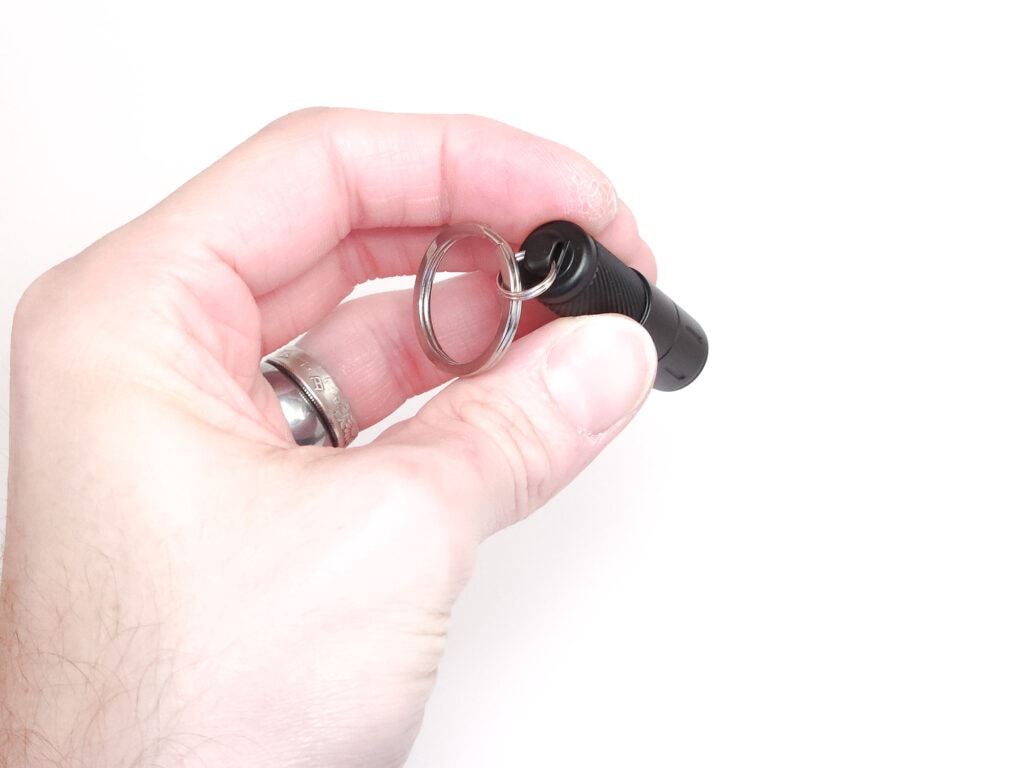
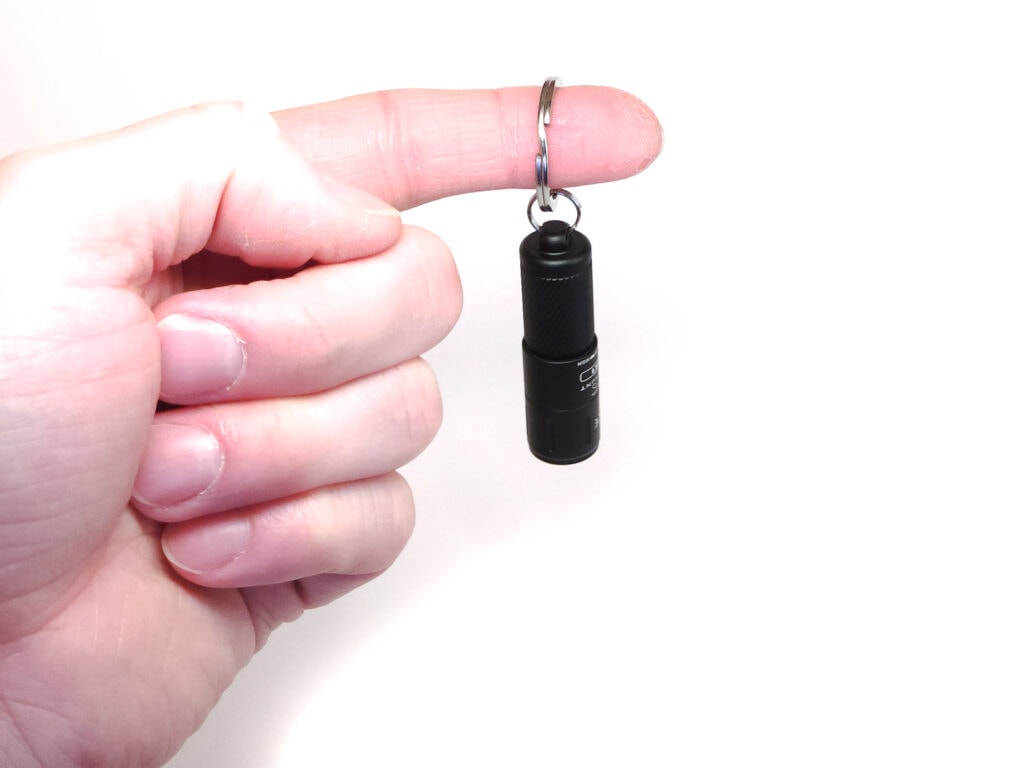
Build Quality, and Warranty
The EK1 comes in four anodized colors: Black (as my test model is), blue, green, and orange, and like all Skilhunts, it’s made of aluminum. On what I’d call the “front” of the light, they’ve etched Skilhunt’s name and logo, the light’s name, the aforementioned usage diagram, and a CE marking. That may not seem like a lot of branding, but given that this is a tiny light, it takes up a bit of real estate. At least it’s all in one place.
The first thing that I noticed when I got this light and turned it on was the horrible grinding of unlubed threads. I don’t know if that’s just on my early model or if they all leave the factory like that, but it started out as a disappointment, especially because those threads are inside the head of the light. If I left it at that, it would’ve been a deal breaker in my eyes. Imagine having to endure that grinding every time you wanted to use your light. More on that in a second.
As mentioned before, twisting the body clockwise will close the gap between the body and head and activate the light. If you turn it the other way, the head and body detach and pop apart*, revealing the USB C charging port. With USB C being so prevalent, you can plug in the included short cable or just about any other USB C cable you have lying around to charge it up. There’s also an indicator light under there to tell you when it’s complete.
*When you unscrew the head from the body, the two pieces separate, but not completely. This leads us back to the threads. Yes, while under normal circumstances, the head and body do not completely come apart… But they’re obviously two separate pieces, and had to be put together somehow, so I started playing around with it. I found that by pulling and rotating the head and body around at the same time, I could pop them apart!
(It’s hard to describe this motion; it’s not twisting like you do to unscrew it; think about bending it between your hands as if you were trying to break a stick in half but also pulling, then rotating your wrists together in the same direction while applying the same forces, making a circular motion in the process. Hopefully that makes sense.)
And pop it will. There’s a light spring inside which keeps the head and body separate while the charging port is accessible and that will definitely fly across the room, so keep an eye on it.
The first thing I did once I got it open was taking pictures. Then I lubed up the threads and snapped it back together, and it was much, much better. I really hope that this was only a problem with my test unit, because if none of them have lubrication, that makes it so much harder/worse to use.
On the inside, the connection mechanism is a two-stage, spring-loaded positive post. As you twist the head down, the smaller inner post will make contact first to activate low; as you keep twisting it down, the spring pushing that post up will be compressed so low remains on, and you’ll eventually tighten the head down enough to make contact with the second stage of the post, which will provide additional power to enable high mode. Knowing this isn’t necessary for using the light, but I just thought it was interesting!
The EK1 is covered by Skilhunt’s standard warranty. You can read the full text of it on their service page.
To summarize:
- Free product replacement due to defect within 15 days of purchase
- Free product repair due to defect within 24 months of purchase
- Paid repair available after 24 months
- Warranty may not be honored if purchased from unauthorized dealer
- Warranty does not cover normal wear or non-defect damage
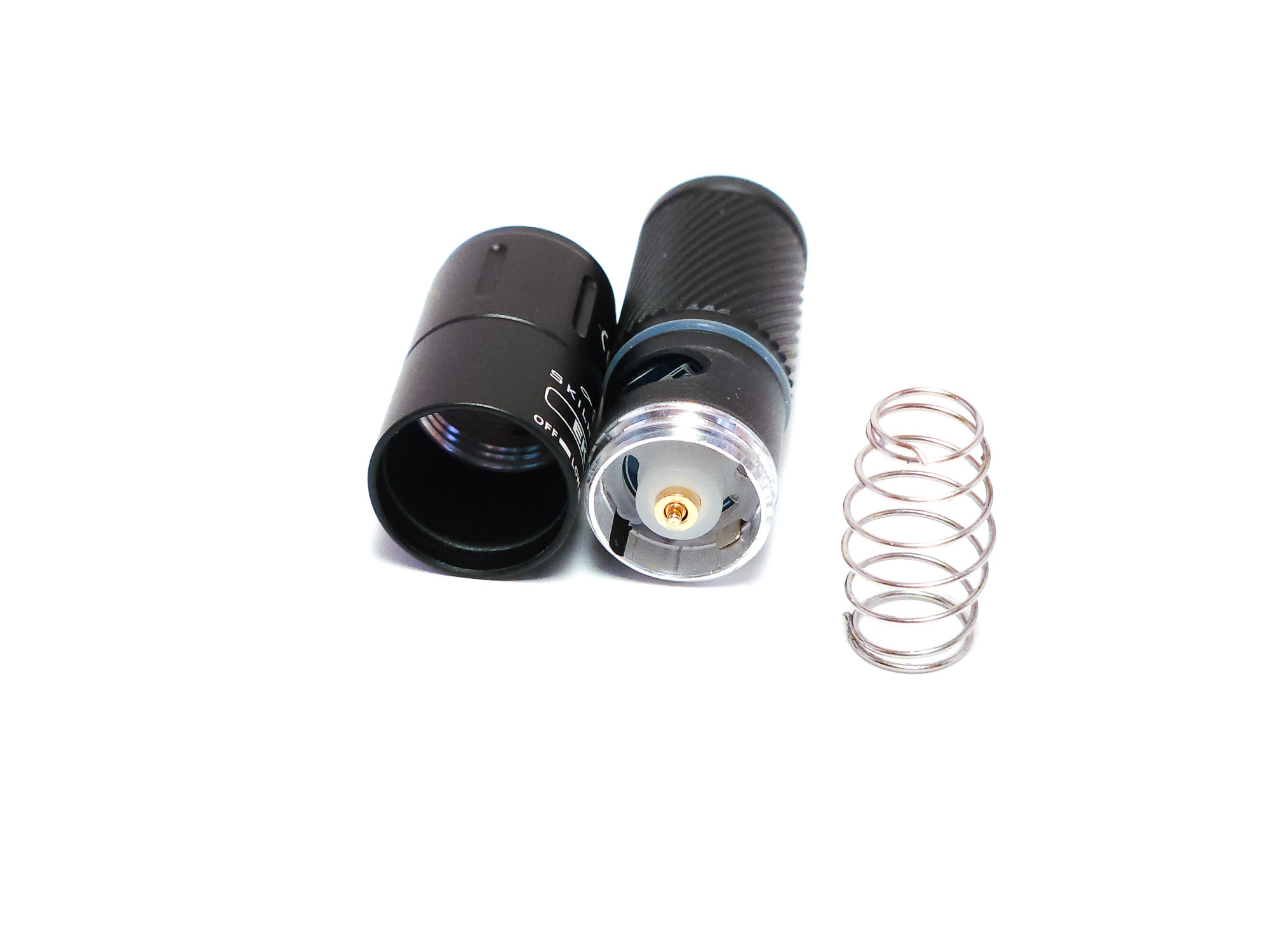
LED, Lens, Bezel, Beam, and Reflector
I would definitely like to see the 219F version of this light, because like every SST20 in 6500K, this one’s pretty green on low. High is better, though. The narrow TIR on this light produces mostly a hotspot, with some dim spill. The spill is still there, but unlike on reflector lights, it’s kind of vague; there’s no strongly defined circle of light that surrounds the hotspot. On high, there’s obviously a lot more spill than on low, but it really does feel like it’s actually “spilling” out of the hotspot. You also get a bit of a halo surrounding the hotspot on high.
Since this is a tiny light, there’s no glass lens to cover the TIR, though it is recessed from the edge of the smooth bezel due to being pressed in from inside the head.
On my test model, while I’m twisting the light through high mode so that it’s fully tightened, the light flickers as if it’s not making great contact. This is only while tightening, though. If I just leave it still once it’s on high, it’s fine.
Interestingly, even though Skilhunt lists the EK1 with a 6500K SST-20, my Opple Light Master Pro measurements came in around 5100K and 5300K for low and high respectively. This could just be because this small light doesn’t even come close to using the full output of the SST-20, and CCT rises as output does. It also reported that the EK1 uses PWM to achieve low mode, but it’s fast enough not to be visible

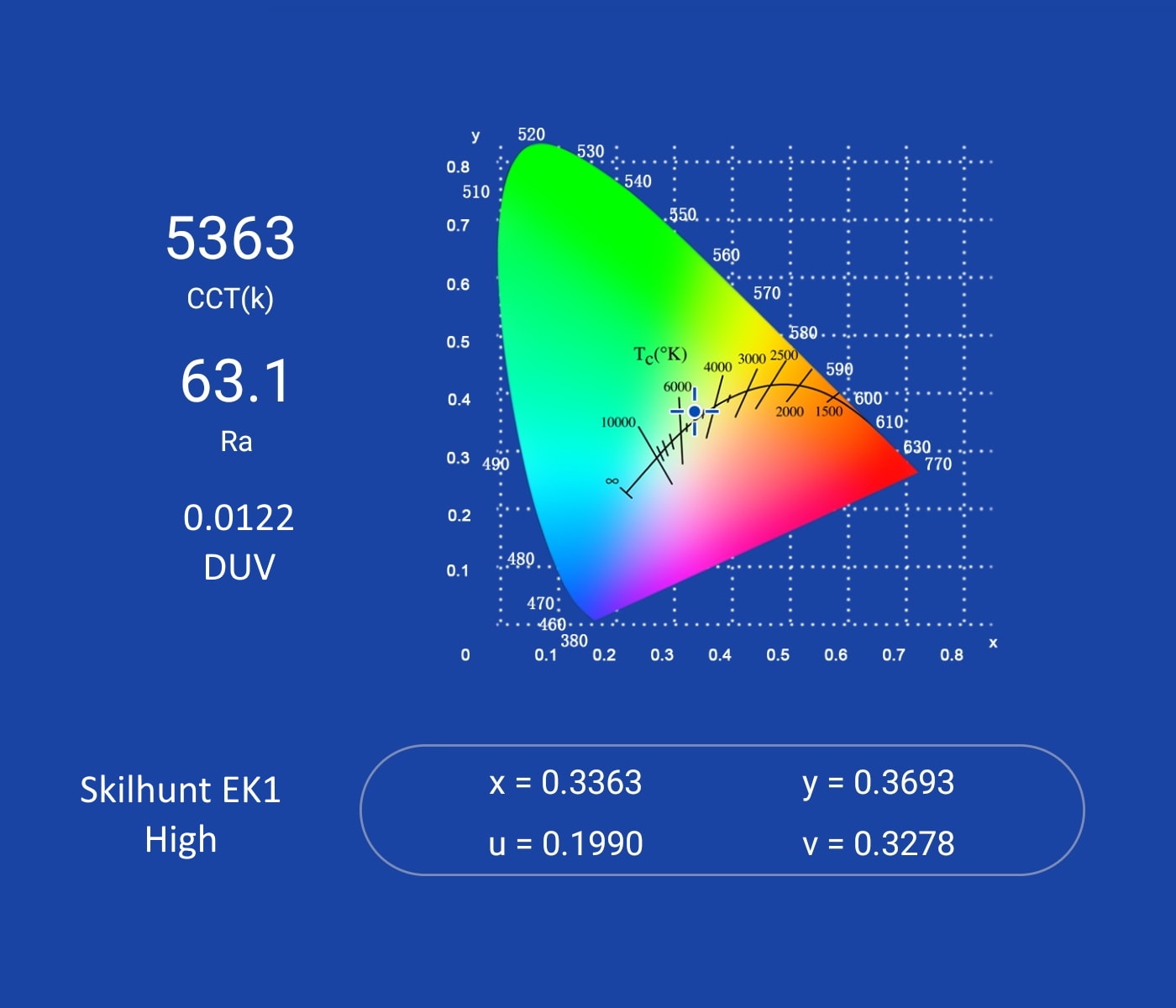
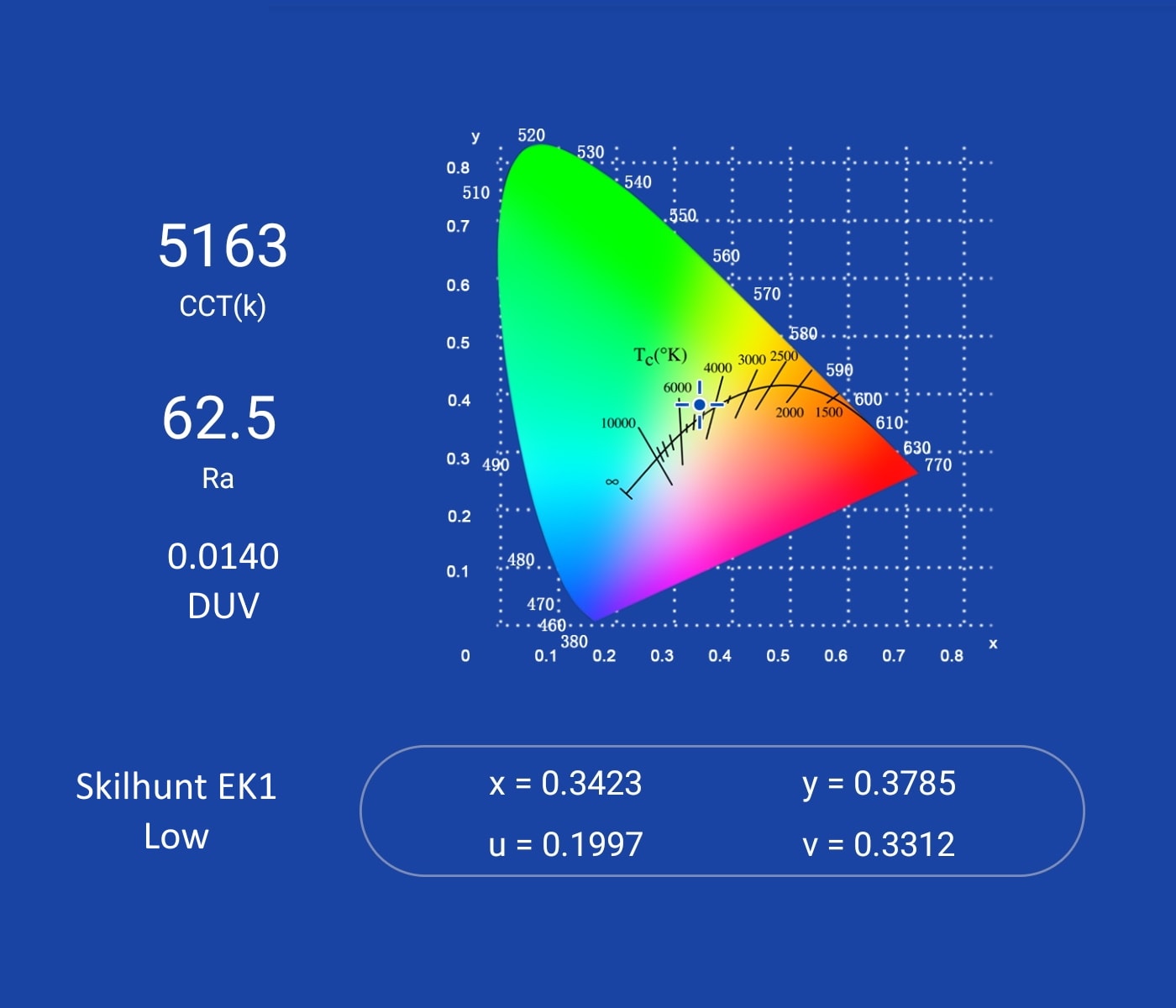
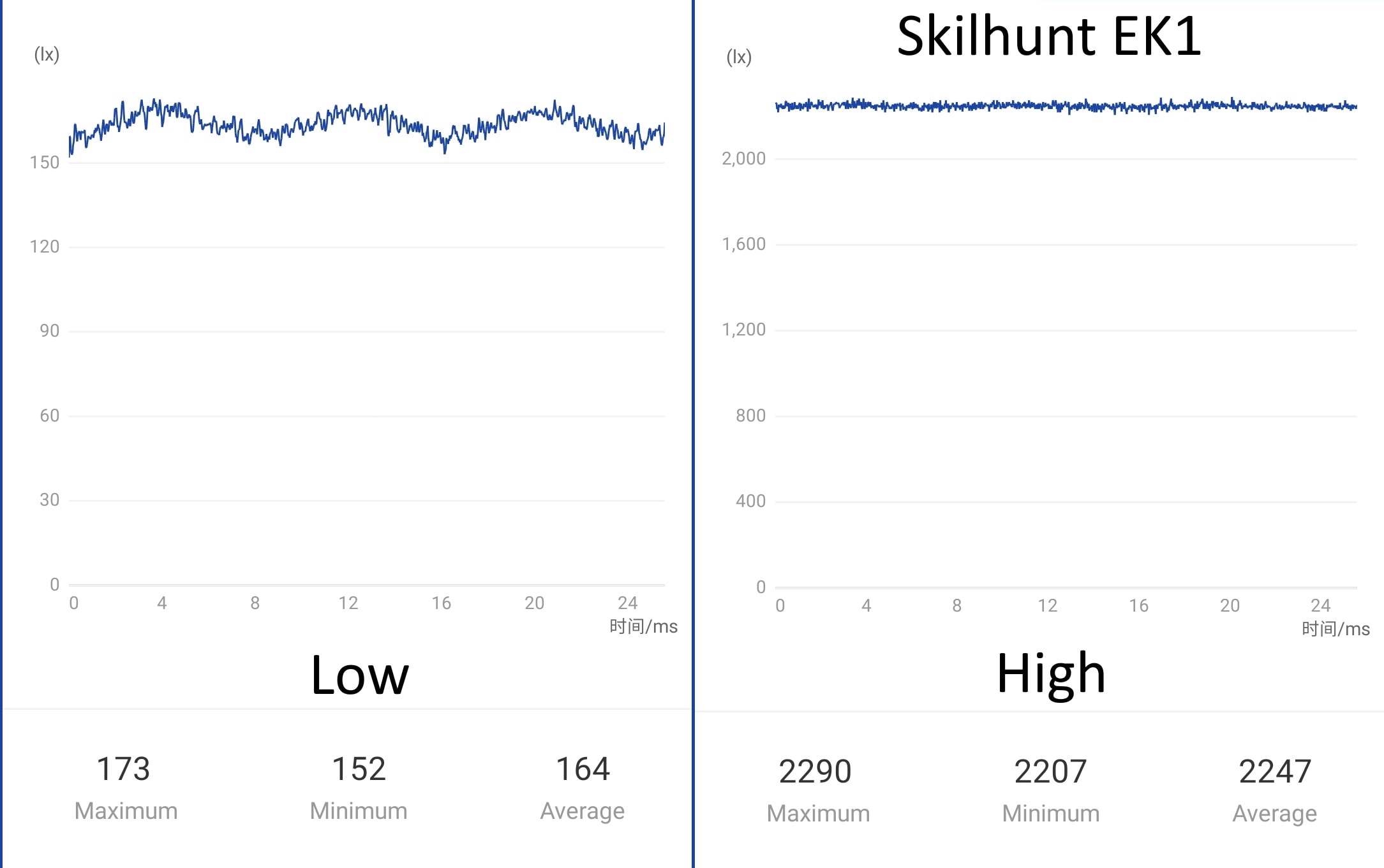
Dimensions and size comparison
Dimensions:
| Skilhunt EK1 | Millimeters | Inches |
|---|---|---|
| Length, tightened | 50 mm | 2.0 in |
| Head diameter | 15 mm | 0.5 in |
| Body diameter | 13 mm | 0.5 in |
Dimensions are rounded to the nearest millimeter, and to the nearest tenth of an Inch.
Weight:
| Skilhunt EK1 | Weight in grams | Weight in oz |
|---|---|---|
| With battery, without keyring | 17 g | 0.6 oz |
Weight is rounded to the nearest gram, and to the nearest tenth of an Oz.
Flashlight size comparison with its competition:
Group 1: Olight iTHX (i1R2 EOS), Skilhunt EK1, Olight i1R2 Pro
Please turn your device upside down to view this comparison photo of the EK1 and its Olight competitors with the labeling right side up.
The EK1 is almost as long as the i1R2 Pro, but the head is slightly narrower than the i1R2 EOS, which is narrower than the i1R2 Pro.
Group 2: Olight i3E EOS, Skilhunt EK1, Manker E02 II
Even the shortest of AAA lights can’t match the tiny size of the EK1!
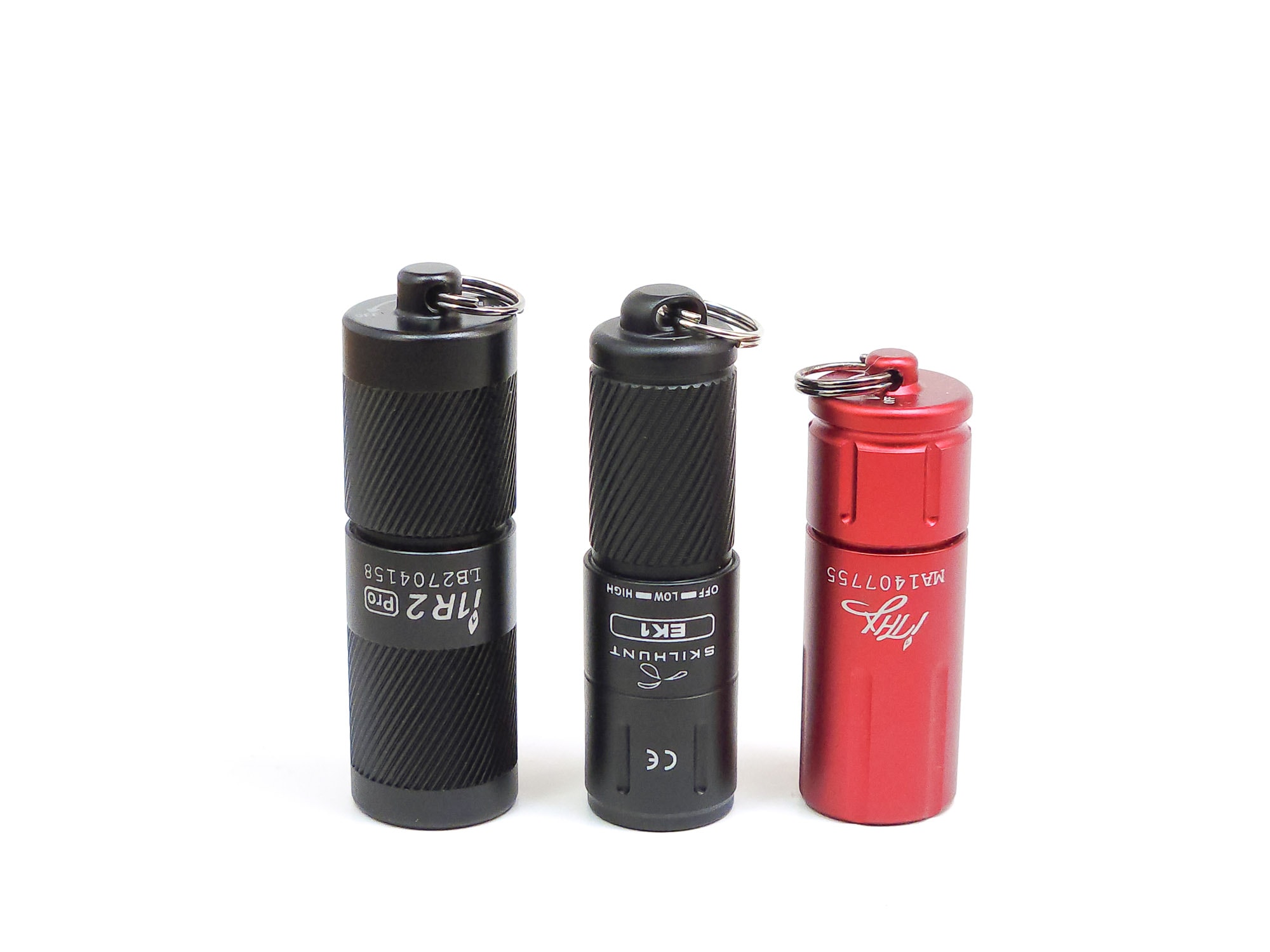
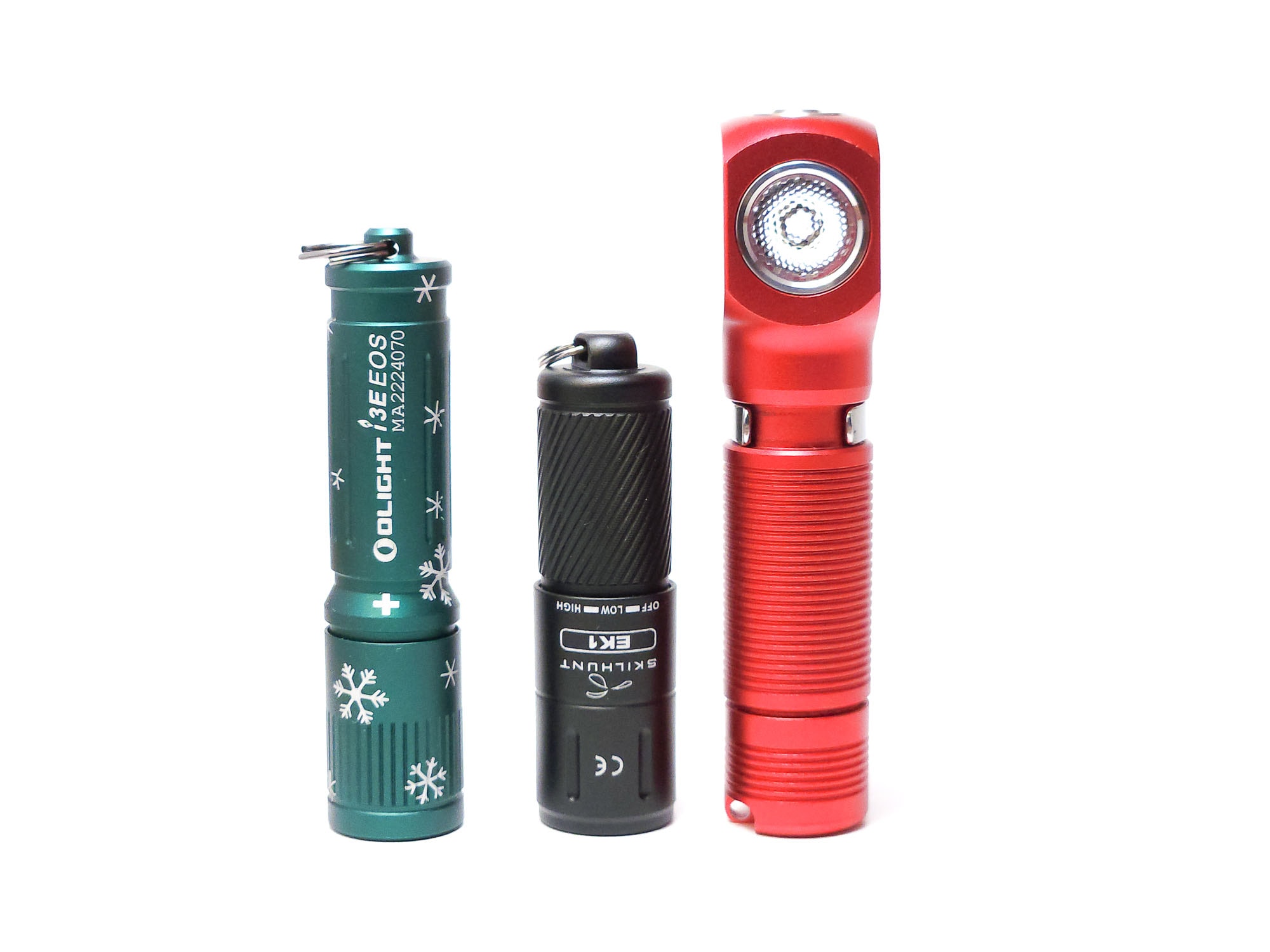
Driver & User Interface:
Available modes:
- High, Low
Available blinky modes:
- None
From OFF:
- Twist slightly clockwise: Low
- Twist further clockwise: High
From ON:
- Twist all the way clockwise: High
- Twist counter-clockwise: Off
Mode memory:
- None
Shortcuts:
- None
Low voltage warning:
- None, though the output decreases with the battery’s voltage.
Strobe/blinkies
- None
Lock-out mode:
- The light is physically disconnected when off.
PWM
- While there is PWM on low, it’s not visible by the naked eye or my phone’s camera.
Additional/summary info on the UI:
- That’s it, that’s the UI!
Batteries & Charging
Skilhunt built the EK1 around a tiny 10220 battery. That’s half the size of a AAA! It still manages to have 130 mAh, though, and with such a low draw from the emitter, it’ll last a good long while on low.
On that note, I do not believe the EK1 has low voltage protection of any kind. It’s not mentioned anywhere on the product page, and after I did my runtime tests, I took the head and body apart to measure voltage between the body and the center post, and got 2.52V on the first abandoned test, but for the runtime tests when I let the light shut off, it measured 0.00V. Therefore, I would highly suggest that you recharge the light once the high mode drops down to be about the same intensity as the low mode in order to protect the battery.
Skilhunt included USB C charging on the EK1 since the battery is built in. They advertised about an hour and a half to charge, and I would say that’s accurate if you’re charging from the point when high mode ends its ANSI runtime (see runtime table below). If you run the battery all the way down to the point where it turns off, charging takes about two hours. Either way, it finishes charging at about 4.20V.
It is important to remember that since the battery is built into this model, eventually it will wear out and that will mean the end of life for the light. If you were really determined to save it, you could probably pull all the innards out of the body and put a new battery in, but it might also be more hassle than it’s worth. Lithium-ion batteries can last for several hundred charges, but it’s something to keep in mind.
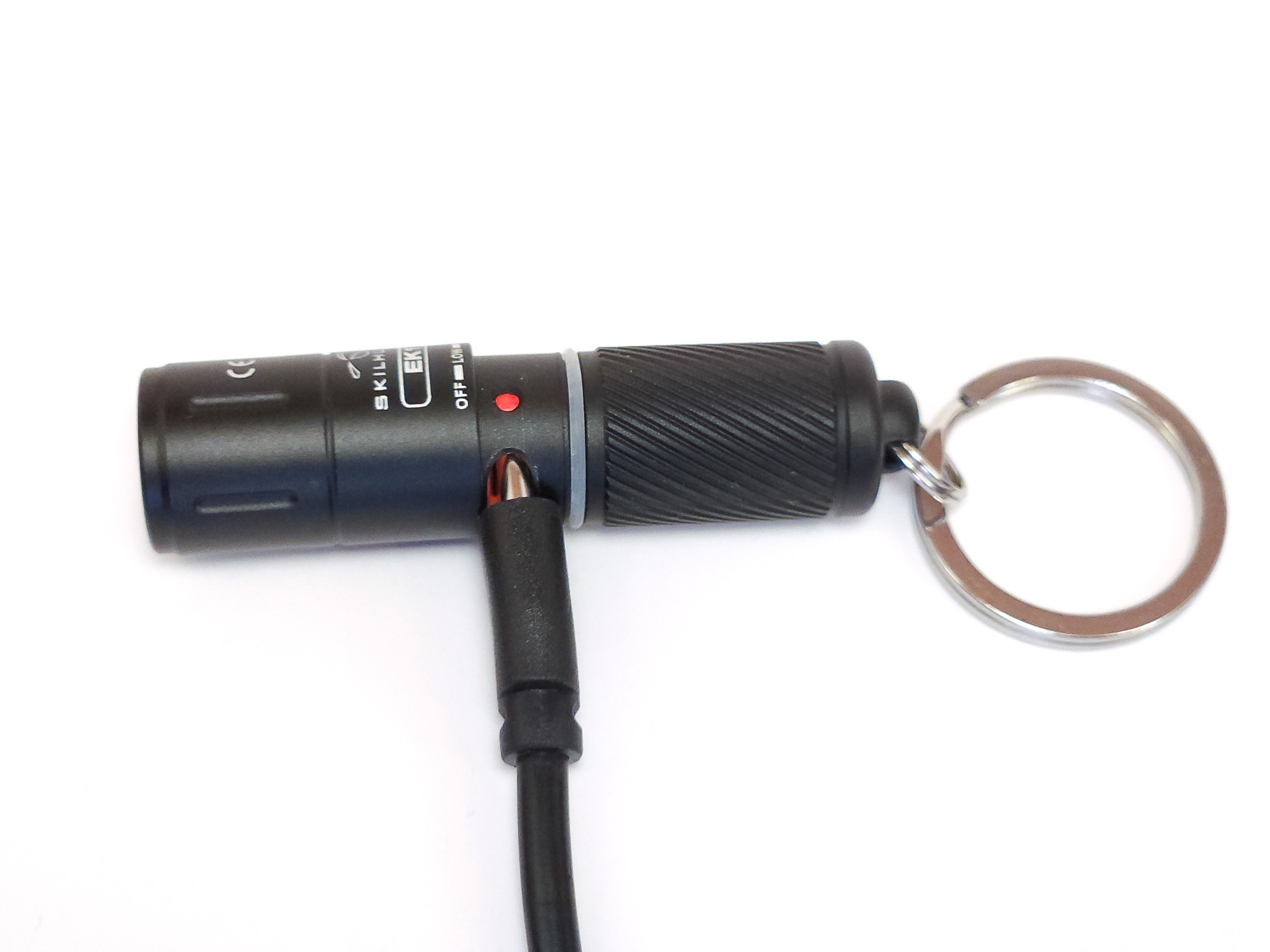
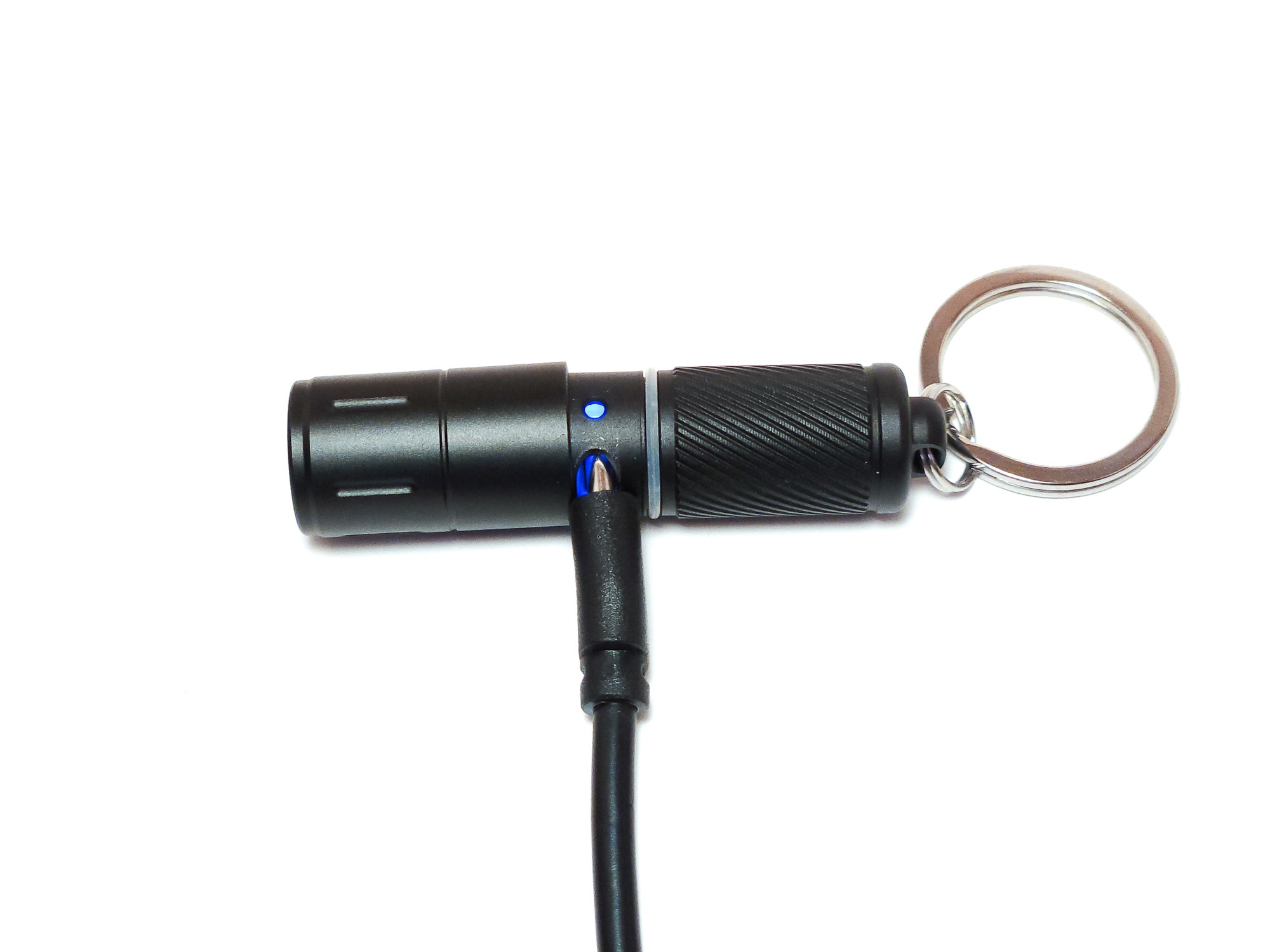
Performance test
To obtain these numbers, I used a very rudimentary integrated shoebox and ceilingbounce on my Samsung Galaxy S10. Measurements have been calibrated using a standardized calibration light provided by 1Lumen.
Lumen measurements (for each mode)
The EK1, being small, has a small amount of output
| Mode | Specs | turn on | 30 sec | 10 minutes |
|---|---|---|---|---|
| Low | 10 | 11 lm | 11 lm | 11 lm |
| High | 180 | 161 lm | 152 lm | 117 lm |
Parasitic drain:
- Unable to measure but presumably zero, as the head is physically disconnected from the body.
It’s not possible to measure amps on this light as it requires the body to be disconnected from the head to access the connection points.
Battery Life: Runtime graphs
There’s a couple of things to note with the EK1’s runtime.
First, I’m happy to see that not only did it exceed specified ANSI runtime, it lasted a good long while after that before finally shutting off.
Second, the first time I ran the test on high, it lasted nearly 7 hours before I stopped it out of concerns for the battery (see the Batteries and Charging section for details). When I re-ran the test, it shut off at the time indicated in the table below.
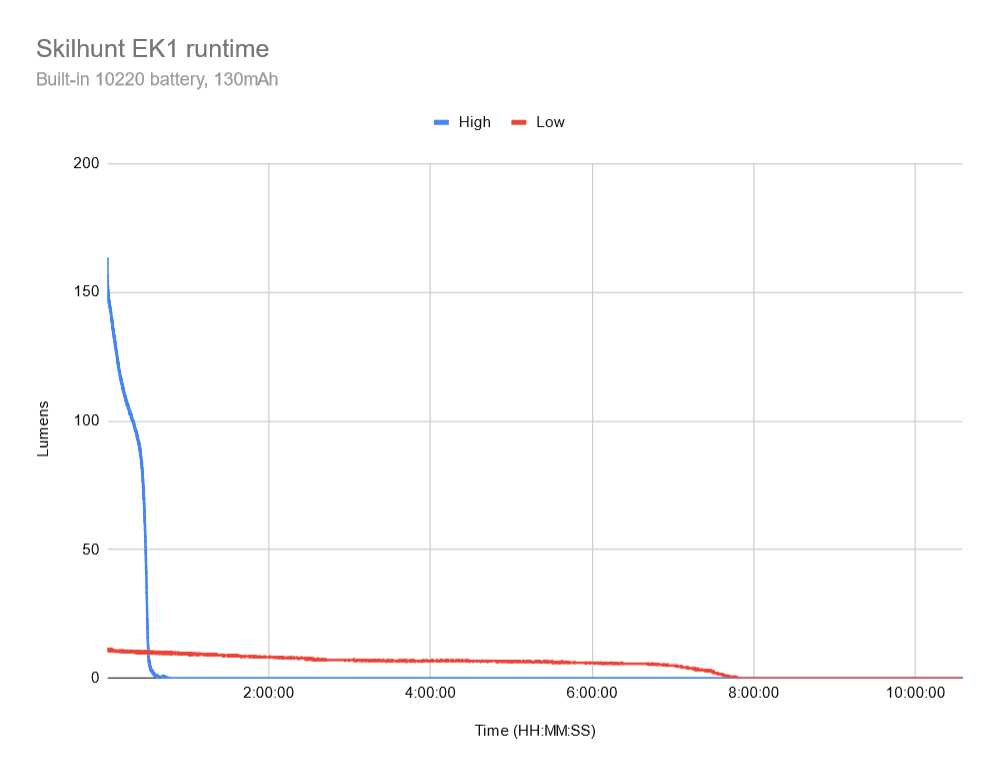
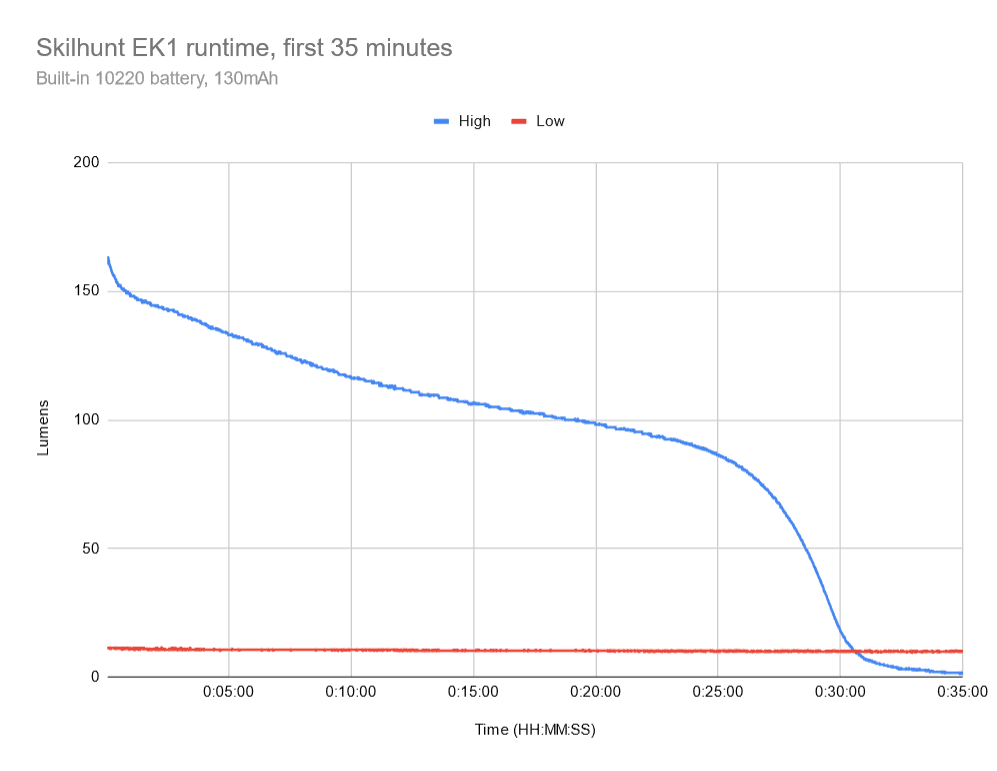
| Mode | Specified | Measured runtime ANSI | Time till shut off |
|---|---|---|---|
| Low | 7h 30min | 7h 37min | 10h 35min |
| High | 25min | 30min | 5h 24min |
ANSI FL1 standards: The runtime is measured until the light drops to 10% of its initial output (30 seconds after turning on). This does not mean that the flashlight is not usable anymore. The last column shows how long the light actually works till it shuts off. If there is a + symbol, it means that the test was stopped at that particular point, but the light was actually still running. This happens on certain occasions, with certain drivers, firmware, or batteries.
Peak beam intensity and beam distance measurements
The numbers for candela were obtained with a UNI-T UT383S luxmeter at 5 and 15 meters for high, and 1 and 2.5 meters for low, then averaged.
| Mode | Specified | Candela measured | Meters | Yards |
|---|---|---|---|---|
| Low | 70 cd | 106 cd | 21 m | 23 yd |
| High | 1,100 cd | 905 cd | 60 m | 66 yd |
This seems logical, given that output on low is slightly higher than specified, while output on high is lower than specified.
Extra info: Peak beam distance according to ANSI FL1 standards: The calculated value of distance in meters at which the flashlight produces a light intensity of 0.25 lux. (0.25 lux is about the brightness of a full moon shining on an object). The columns ‘Meters’ and ‘Yards’ use rounded numbers.
Beamshots
These were taken with a Samsung Galaxy S22+ using pro mode and the following settings:
- WB 5000K
- ISO 200
- Speed 0.5
Due to the small size and lower output of this light, I’ve taken comparison beam shots against my garage door instead of the usual sports field. You’re more likely going to be looking at something 10 feet away with the EK1 than 100 meters, especially given the throw on it.
You can see how on low, the EK1 is the most green out of all the lights, though it’s better on high. Also note that there is a lot less spill when compared to the Olight i1R 2 models.
Beamshots of the following flashlights compared:
- Skilhunt EK1
- Manker E02 II
- Olight i1R 2 EOS (iTHX)
- Olight i1R 2 Pro
- Olight i3E EOS
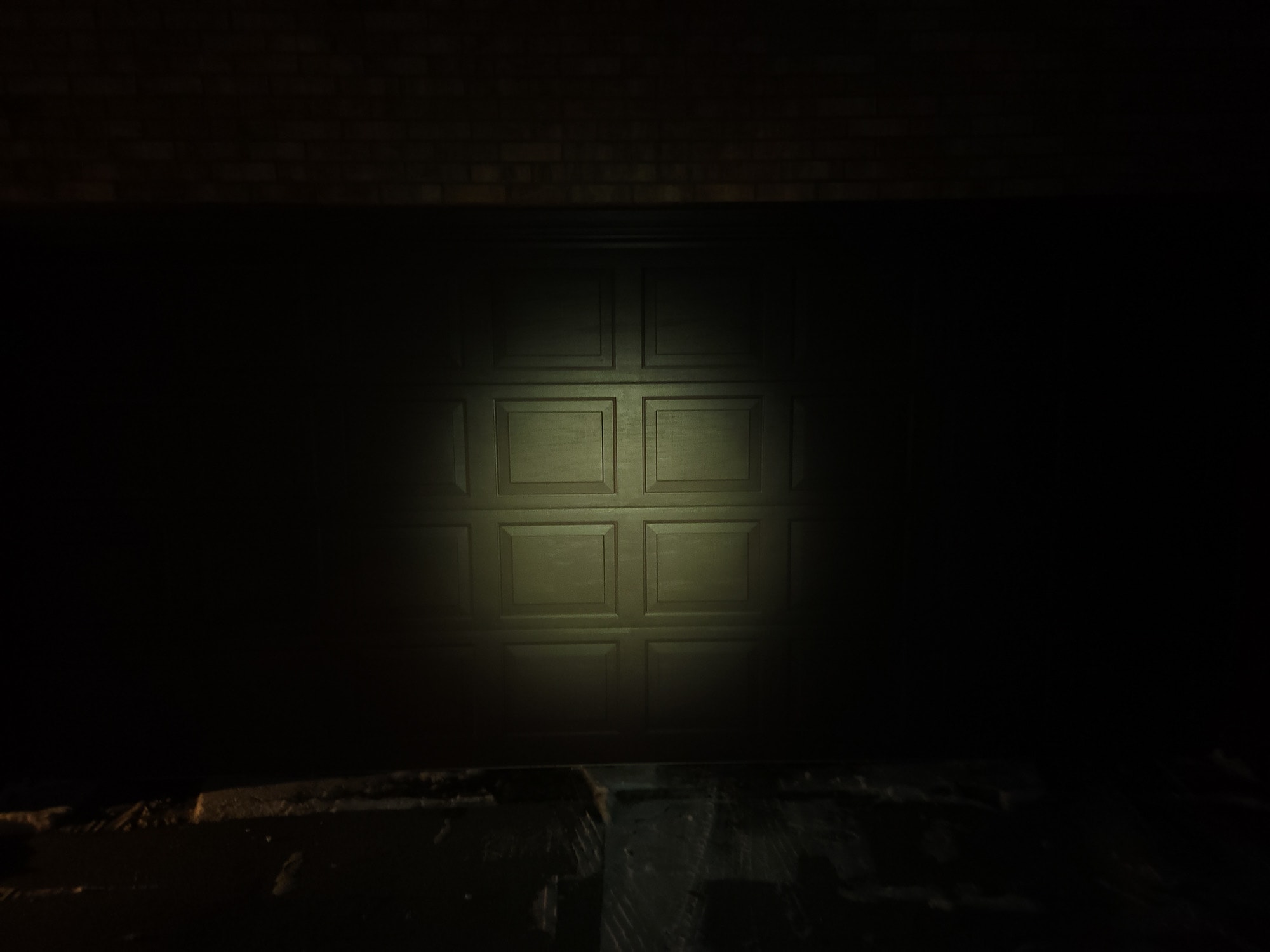
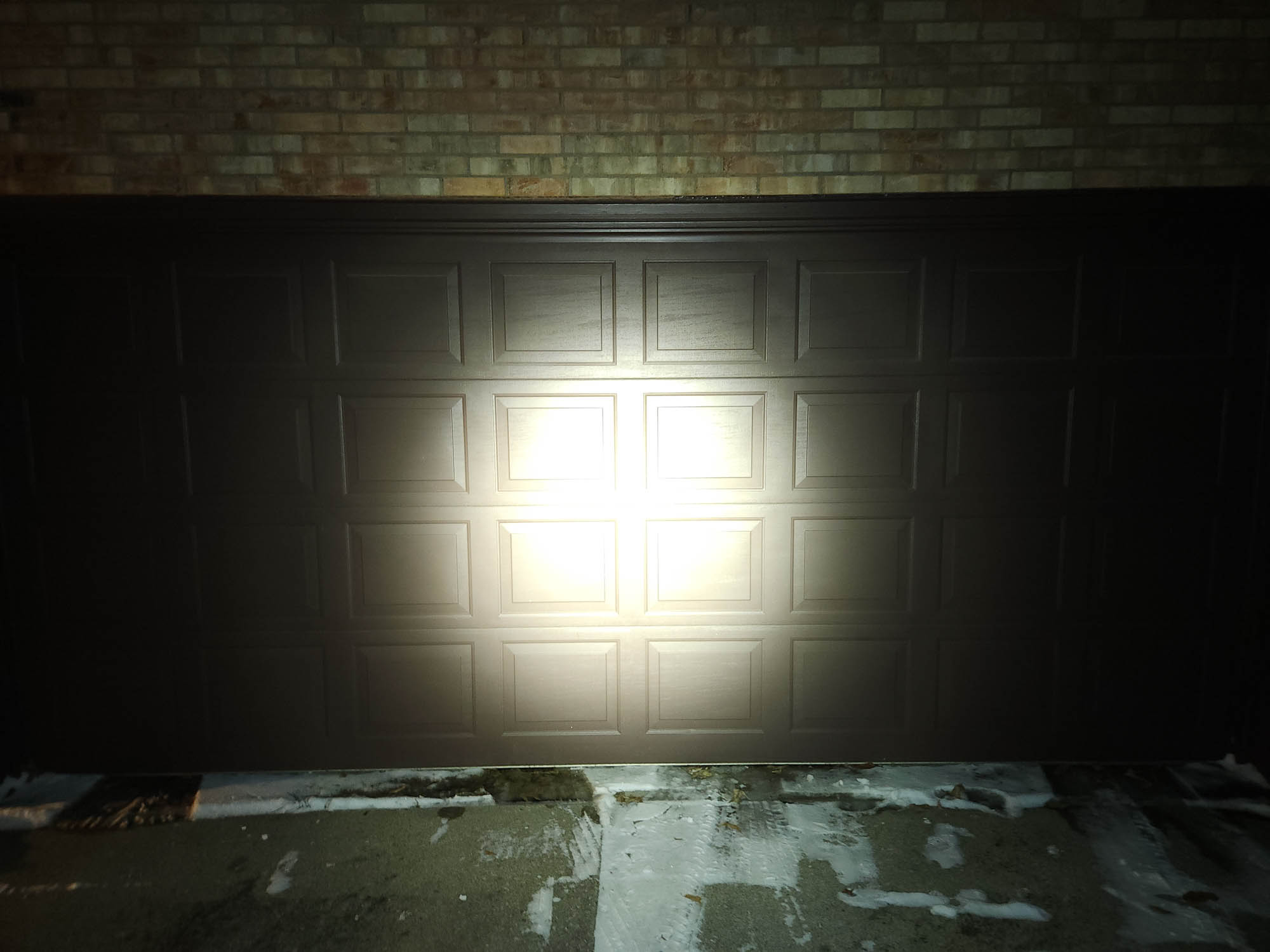
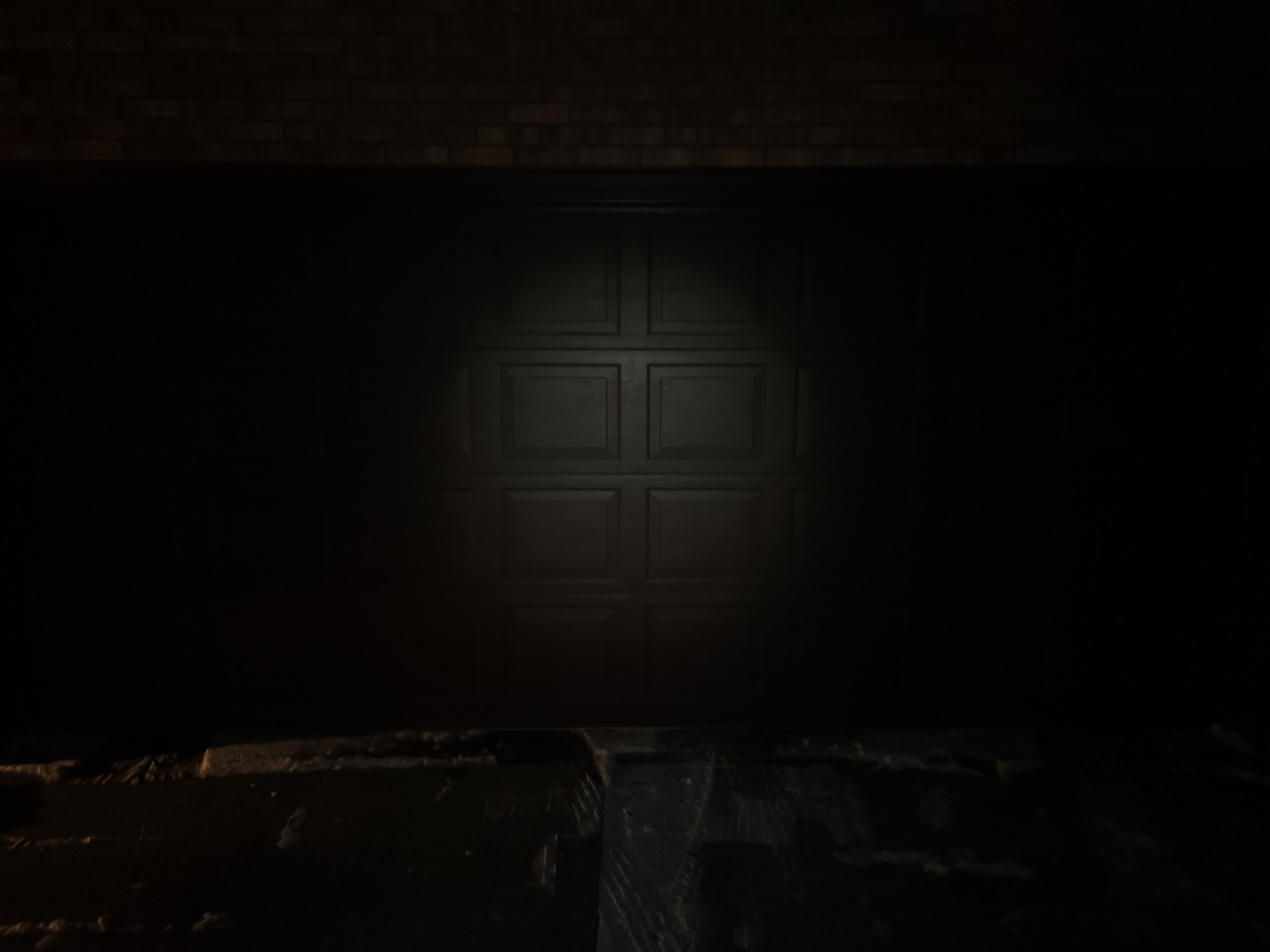
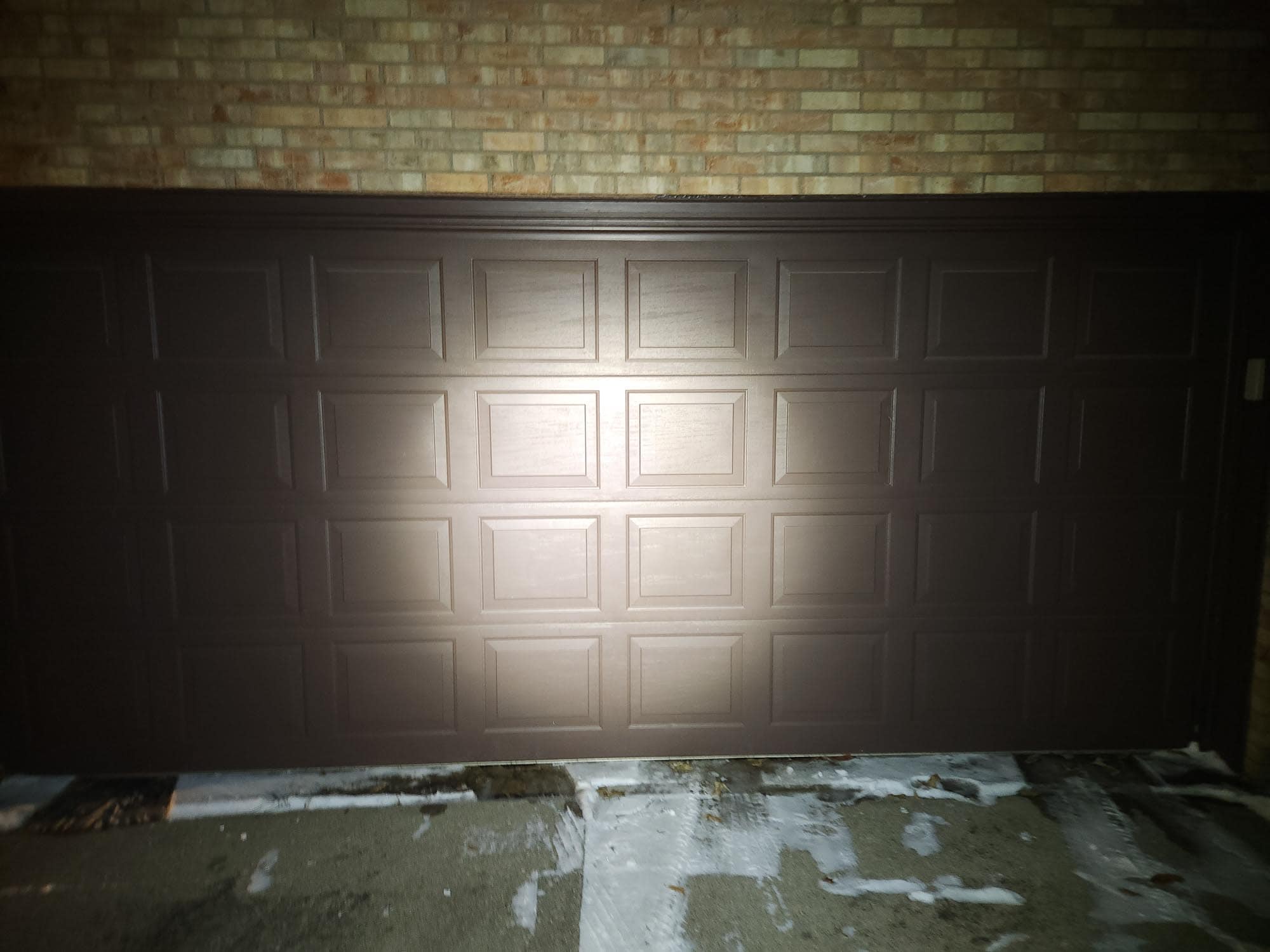
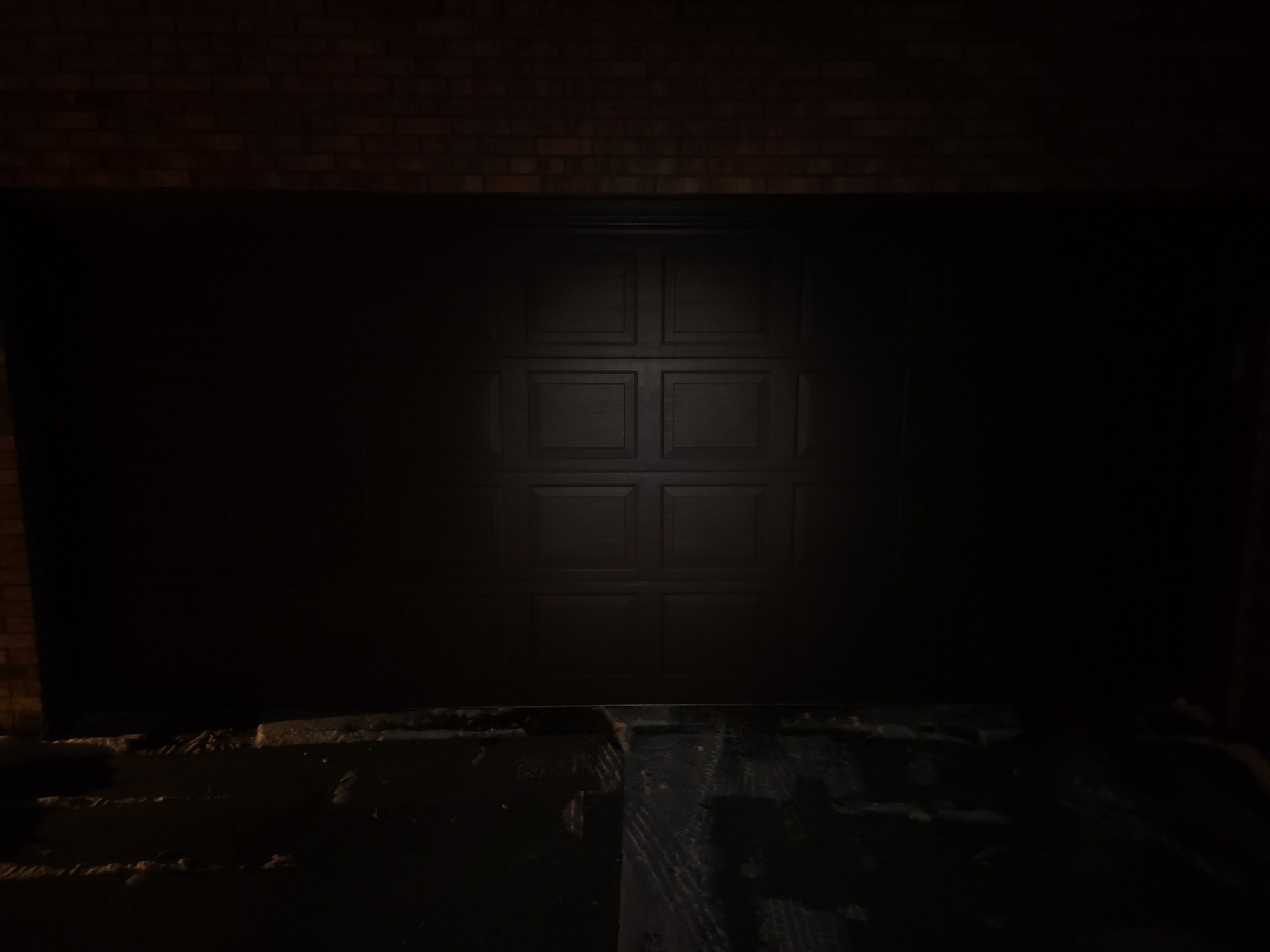

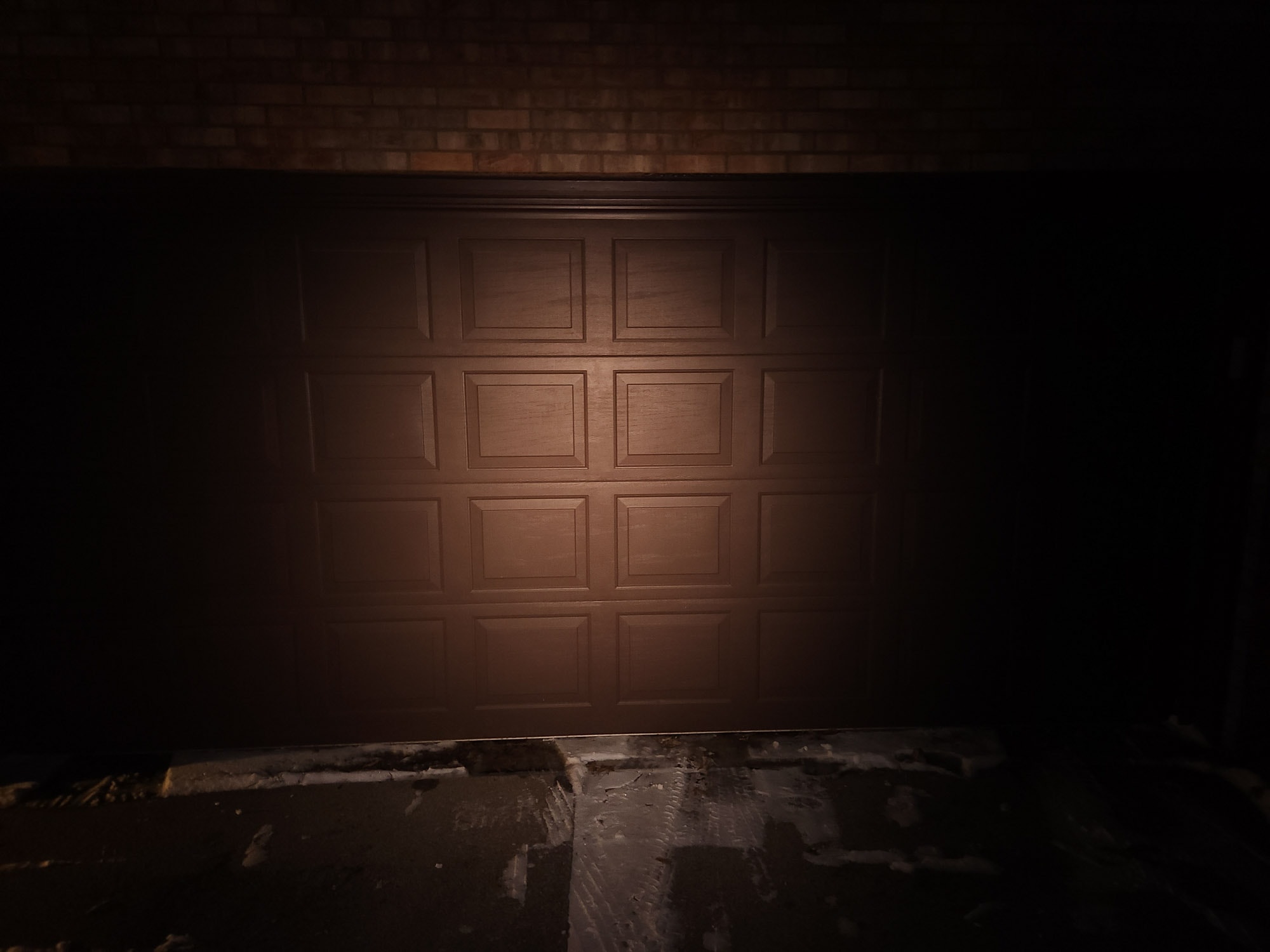
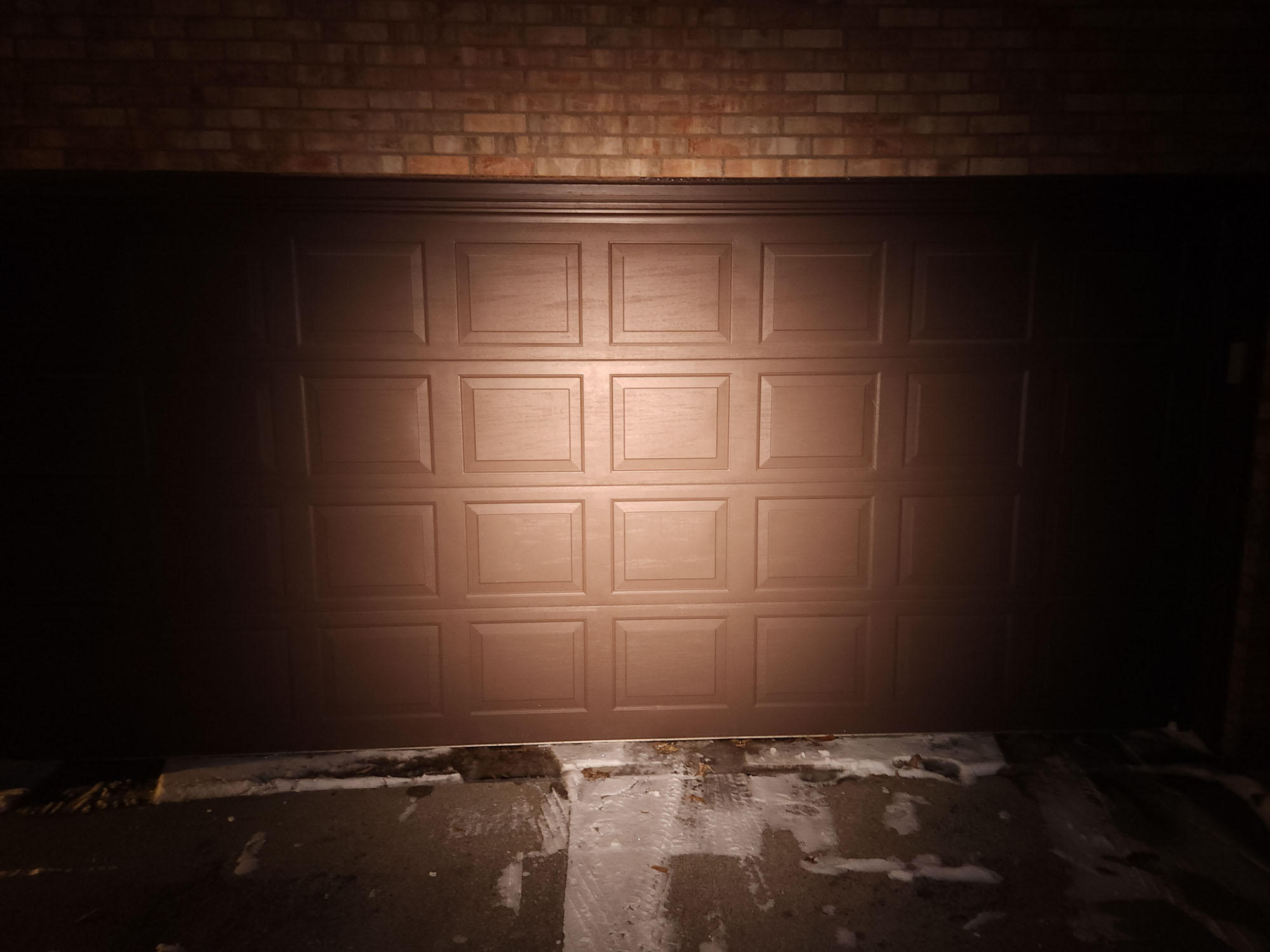
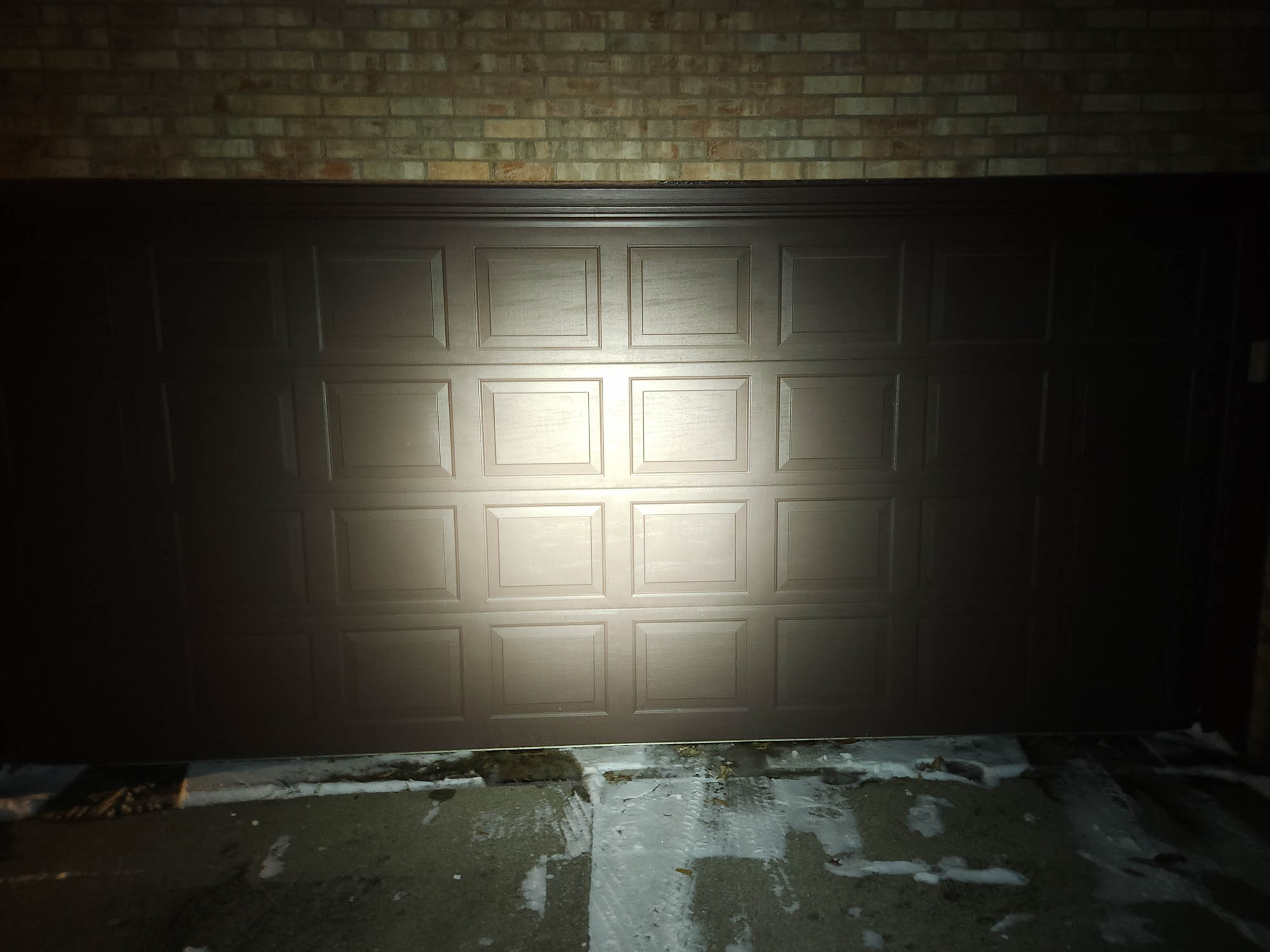
Disclaimer: This flashlight was sent to me for review at no cost by Skilhunt. I have not been paid to review, nor have I been holding back on problems or defects.
Final Verdict
Pros
- Smaller than the competition
- Optional neutral high CRI emitter
- Comes in four fun colors
Cons
- Hidden threads were unlubed
- SST-20 very green on low
- Built-in battery means the light will eventually die
- Flicker while screwing down high
Explanation on star ratings:
1: Avoid: a match would be a better choice – 2: Poor: significant defect or issues; almost unusable – 3: Average: some defects or issues; but still usable 4: Good: recommended (minor issues) – 5: Great: highly recommended

4 stars: ★★★★
The EK1 is Skilhunt’s latest keychain light; a two-mode twisty with built in battery and charging. While it does have its flaws, like greenish 6500K emitter, flicker when you’re tightened down the high mode all the way, definite end of life, and worst of all, unlubed threads, it’s still handy to have around whether on your keychain, zipper, or elsewhere. If you need a tiny light and you prefer recharging over swapping batteries, you might want to check this one out.
I give the Skilhunt EK1 four stars. If I had the Nichia version, it might’ve scored higher, but the unlubed threads still knock it down a point.
Buy Skilhunt EK1 with a discount
Get 6% discount at Skilhunt by using the following discount code: blf06
1lumen selects and reviews products personally. We may earn affiliate commissions through our links, which help support our testing.